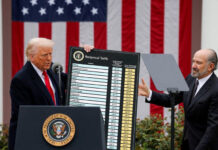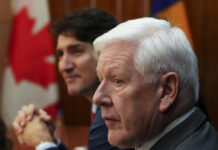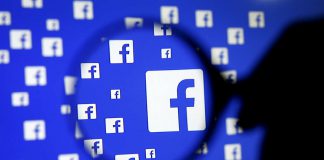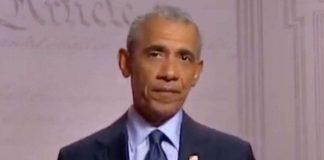AUGUST 7, 2020
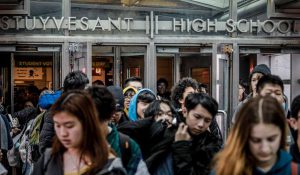
Students at Stuyvesant High School leave after classes in New York on March 13, 2020. New York Gov. Andrew Cuomo said Friday, Aug. 7, 2020 that he would allow children statewide to return to classrooms for the start of the new school year, citing the state’s success in battling the coronavirus pandemic. AP Photo/Bebeto Matthews
New York City’s public schools can hold in-person classes this fall, Governor Andrew Cuomo announced, paving the way for the district to become the only major U.S. system to open its doors despite growing unease among teachers, administrators and parents.
“By our infection rates, all school districts can open” with tight precautions, Cuomo said Friday on a conference call with reporters. “Everywhere in the state, every region is below the threshold that we established, which is just great news.”
Parents of pupils in New York City have hours to decide whether to opt out and begin the year with all-remote learning.
While Cuomo said districts across the state have permission to resume in-person classes, that doesn’t mean they will. For months, Cuomo has insisted that he has sole authority to decide whether schools can reopen. But it’s up to local politicians and school administrators to decide how and when schools will open, putting the onus of pulling off New York City’s reopening squarely on the shoulders of longtime political rival Mayor Bill de Blasio.
Of the nearly 750 districts in the state, more than 120 have yet to send in a reopening plan and 50 are incomplete, Cuomo said. He didn’t discuss New York City’s plan.
De Blasio tweeted “We’re committed to getting this right. We will open safely.” The city will learn Monday whether the state considers its reopening proposal complete, said mayoral spokesman Bill Neidhardt.
The largest U.S. system, with 1.1 million students, is defying a national rush to online education. Officials have spent the past five months planning for a hybrid schedule in which students would attend school one to three days a week, depending on a building’s capacity. The rest of the time, the district intends to offer online learning.
Yet the spring’s scuttled semester had parents struggling to work and teach their children simultaneously, forced businesses to navigate those conflicts, and kept the virus-wracked country that much further away from normality.
Major school districts that have opted for virtual instruction for at least the start of the year include Los Angeles, Chicago, San Diego, San Francisco, Miami, Atlanta and Houston. But Cuomo said New York is ready.
“We are probably in the best situation than any other state in the country right now,” Cuomo said. “If anybody can open schools, we can open schools.”
The decisions about travel, business and education are being made against unrelenting pressure from President Donald Trump, whose theories on the topic aren’t always supported by his own health experts.
“This thing’s going away — it will go away like things go away and my view is that schools should be open,” Trump said Wednesday on Fox News. Children “are virtually immune from this problem. And we have to open our schools.”
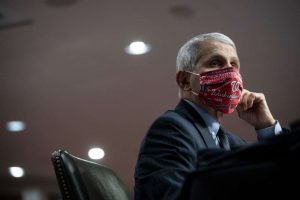
Health Chiefs Testify Before Senate HELP Committee On Covid-19. Anthony Fauci. – Photographer: Al Drago/Bloomberg
Anthony Fauci, director of the National Institute of Allergy and Infectious Diseases, has rejected this claim. There are parts of the country where schools shouldn’t open to in-person teaching, the doctor told Bloomberg Television on Wednesday, and testing for the disease needs to improve, especially in the speed to obtain results.
New York conducted 70,000 tests on Thursday, of which 1% were positive, Cuomo said. There were five virus-related fatalities and 579 hospitalizations, according to the latest state data.
Cuomo said there’s still a high level of concern from parents and teachers, and directed school districts to post their remote learning, contact tracing, and coronavirus testing plans online.
All school districts must also have discussions with parents to answer their questions and must be set by Aug. 21, he said.
“There should be at least three discussion sessions with parents where the parents are given notice,” Cuomo said
Large school districts like New York City must set up five discussions due to the large number of students. The districts will need to meet separately with teachers as well, he said. “You need two things to open up the schools: students and teachers,” Cuomo said.
Prior to Cuomo’s announcement, de Blasio said he’d withhold comment until there’s a formal decision from the state.
He defended his plan for blended instruction, despite pushback from the teacher’s union, state officials and some parents, by pointing to a survey in which 75% of parents wanted their children to return to school. The mayor had said New York City wouldn’t open schools unless the city remains below a 3% citywide infection rate over a seven day rolling average.
“We are trying to maximize in-person learning for the good of our kids because we know it makes a world of difference,” de Blasio said during a news briefing Monday. “Nothing replaces in-person learning.”
A city plan called for cleaning schools during the day and at night, with enforced social distancing in classrooms and hallways, mandatory face coverings for all, featuring hand washing and hand sanitizer stations. “I feel like we’re where we need to be to get ready for opening day,” de Blasio said during an interview on NY1, a local all-news cable channel.
Studies of Children
There is conflicting data about how Covid-19 is transmitted to and from children,
A study published in the Journal of the American Medical Association last month suggests infected kids with even just mild symptoms can still have 10 to 100 times the concentration of SARS-CoV-2 in their noses and throats as older kids or adults, making them more likely to spread it. An earlier Chinese study, however, found that most children with Covid-19 admitted to a hospital lived in households with previously infected adults, indicating the child caught the virus from the adult rather than transmitting it.
A small number of kids have died or required intensive care as a result of either the respiratory failure commonly associated with the virus or an inflammatory condition sometimes described as similar to Kawasaki disease that causes heart or circulatory problems.
That leaves school officials largely at the mercy of their local health officials for guidance. In Chicago, the district will work with the city Department of Public Health to assess if it is safe to open with hybrid learning in the second quarter on Nov. 9.
Exposing Inequities
The economic effects of keeping children out of school go beyond matters of convenience and pocketbook. They also expose imbalances in the economy, with some children unable to access the Internet as easily as others.
“The first-order short-term economic impacts will be likely centered around what this does to families needing childcare; loss of school meals for the kids making hunger worse; and whatever furloughing the district is doing,” said Diane Schanzenbach, professor at the School of Education and Social Policy at Northwestern University. “Long term, the costs of all of this lost learning will be with us for decades.”
Senate Republicans have proposed a bill that would provide $70 billion to K-12 schools, but that may not be enough to safely reopen, or even to go remote and provide needed tech to low-income families. More than $116 billion will be needed to safely reopen the nation’s public schools, according to an estimate from the American Federation of Teachers union.
The teacher’s unions have been lobbying heavily against in-person school, citing budget restraints and health risks for staff and pupils.
Courtesy/Source: Bloomberg

























































































